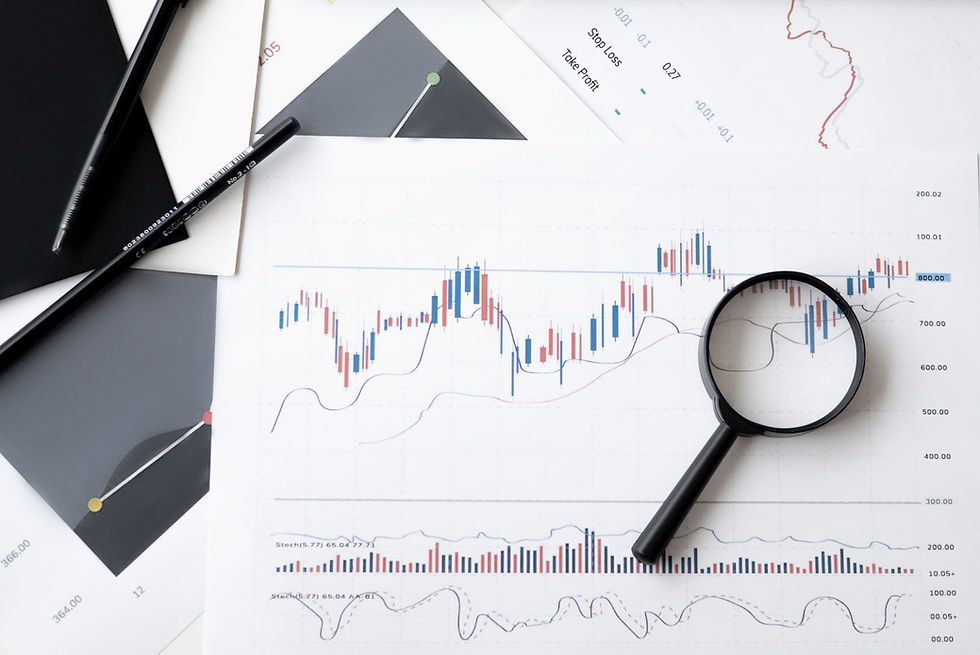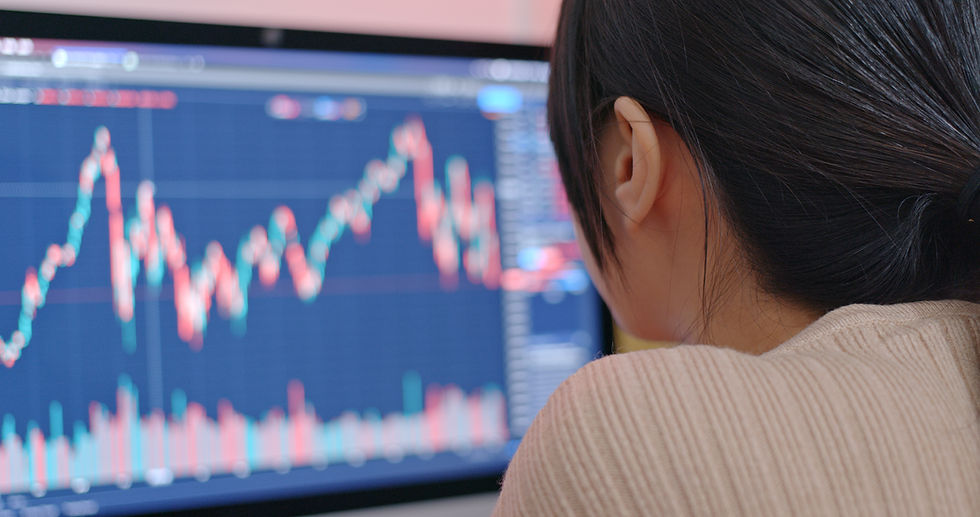Chapter 17: Mastering Trader Psychology — From Emotions to Edge
- Oct 20
- 5 min read
Updated: Oct 23
Turn emotion into process. Build routines that keep you trading your rules, not your feelings.
Trading performance is 20% strategy and 80% psychology. You can have a perfect edge on paper and still blow the account if emotions, routines or small cognitive errors dominate your execution. This chapter gives a compact, practical playbook: recognise the mental traps, install micro-habits to prevent them, and run fast, repeatable recovery routines when things go wrong.
1 — The core idea
Design your trading environment so emotion becomes an input to follow-up actions, not the decision engine.

2 — The most costly trader emotions (and why)
Fear — causes early exits, under-sizing, paralysis. Kills expected value.
Greed — over-sizing, adding to losers, removing stops. Magnifies losses.
Revenge / Anger — a string of bad trades becomes a cascade of larger, stupid trades. The fastest way to blow an account.
FOMO (fear of missing out) — forces late entries at bad prices and poor risk/reward.
Overconfidence — after wins you risk more, ignore tests, and stop journaling.
Awareness is not enough — you must automate the right responses when these emotions appear.
3 — A practical mental model: FAST vs SLOW trading
Borrowing the idea of System 1 / System 2:
FAST (emotional) = immediate impulses, noise reaction, revenge trades.
SLOW (strategic) = your written rules, RFPP (The Risk-First Positioning Principle) sizing, pre-trade checklist.
Your job: make SLOW the default path. Use systems, checklists and short waits to force slow-mode before clicking execute.
4 — The Emotional Check (5-question micro-test)
Before every trade (or before placing any size change), answer these out loud or in one line in your journal:
Is this trade in my written plan? (Yes / No)
Am I risking ≤ my predefined % of equity? (Yes / No)
Is there any recent news/event that could blow up liquidity? (Yes / No)
Am I on tilt (frustrated/angry/revenge)? (Yes / No)
If this trade loses, will I still follow the plan? (Yes / No)
If any answer is No → stop. Either adjust within plan limits (reduce size; move to demo) or skip.
5 — The Revenge-Trade Kill Switch (single rule)
Whenever you hit a daily loss limit (your preset max daily drawdown), you stop trading for the day and perform a 10-minute review. No exceptions.
Make the Kill Switch a hard, recorded rule in your journal and platform (e.g., set a calendar block that prevents orders). This single binary rule prevents cascade-loss behavior and forces reflection.
6 — Daily routine (practical, repeatable)
A short routine builds resilience and keeps emotions predictable.
Pre-market (10–20 minutes)
Check economic calendar and block high-impact events.
Scan your chosen pairs for plan setups (1–3 best setups).
Set max daily loss and today's risk% in your notebook.
Do the Emotional Check once.
During trading
Use RFPP sizing per trade — compute size before entry.
Log every trade pre-entry (entry, SL, TP, lot).
If emotions spike, take a 5-minute off-screen break.
Post-session (10–15 minutes)
Record trades, screenshots of key setups, and one sentence: “What worked / What I missed / One improvement.”
Update running metrics (win rate, avg R, expectancy).
7 — Weekly mental scorecard (use this to see trends)
A one-line daily self-score (0–10) helps spot trending tilt. Fill out at session end.
Rule: If weekly average < 6 — cut position size next week by 25% and do two extra review sessions.
8 — Short, effective exercises to reset (pick one)
Use these when you notice emotional drift.
Box breathing (2 minutes)
Inhale 4s — hold 4s — exhale 4s — hold 4s — repeat 6 cycles.
Grounding (60s)
Name 5 things you see, 4 you can touch, 3 you hear, 2 you smell, 1 you taste. Brings you back to the present.
Micro-walk (5 minutes)
Stand, walk outside, and do nothing trading-related. Movement reduces cortisol.
Write-to-calm (3 minutes)
Write one sentence: “If I do X and lose Y, my plan remains Z.” Forces planning-level thinking.
Use the one that fits your environment — do it immediately when emotional flags appear.
9 — Daily micro-habits that build discipline
Journal one line per trade before entry. The simple act of writing reduces impulsivity.
Limit screen time around open/close churn periods you don’t trade.
Block revenge time: an immutable calendar block after a loss that prevents new orders for X minutes.
Automatic sizing template: pre-fill the lot-size calculation so you don’t eyeball size under pressure.
Small, repeated habits beat rare, heroic discipline.
10 — How to review a losing streak (5-step recovery protocol)
Pause trading for 24 hours. Kill Switch activated.
Collect facts: screenshots, ticket times, entry reasons. Don’t interpret yet — gather.
Check mechanics: slippage, spread spikes, news. Was it execution or strategy?
Hypothesis test: is this a drawdown from normal variance or a structural problem?
Action: If mechanics fault → raise stop margins or move accounts. If strategy fault → halt strategy and move to demo until restored.
Do not “win it back.” Winning back is emotional and multiplies risk.
11 — Journaling prompts (short & powerful)
For each trade, answer:
Why did I take this trade?
What is the edge? (One sentence)
How big am I risking (in $ and %)?
Did I follow my rules? (Y/N) — If No, why?
One lesson learned (1 line)
Review the lessons weekly and convert repeated themes into rule updates.
12 — Measuring psychological health (simple KPIs)
Track these weekly:
Emotion score (avg) — see section 7.
Adherence rate (%) — % of trades that followed pre-entry plan. Target ≥ 90%.
Avg size vs plan — did you over/under-size vs RFPP? Aim for within 5% variance.
Revenge events — count of trades taken within 30 minutes after a loss. Target = 0.
If any KPI drifts, shrink size, revisit rules, or take a three-day cooling period.
13 — When to get coaching / outside help
You hit your max monthly drawdown two months in a row.
You consistently break rules during stress.
Emotional score average < 5 for more than two weeks.
You notice severe anxiety, sleep disruption, or other signs that trading affects daily life.
A short 4–6 session coach engagement often gives structural fixes faster than solo iteration.
14 — Printable Emotional Check Checklist (copy & paste or print)
EMOTIONAL CHECK — BEFORE EVERY TRADE
Is this trade in my written trading plan?
Risk ≤ my preset % of account?
No high-impact news in next 60 minutes?
Am I calm / not on tilt?
If this loses, will I still follow my plan? If any NO → do not trade. Use one reset exercise and re-evaluate.
15 — Final rules to live by (the 7 short commandments)
Risk-first sizing every trade (RFPP).
Never trade after hitting the daily loss limit. Kill Switch = ON.
Pre-write every trade and log it before execution.
When emotion is high, step away using a reset exercise.
Run a weekly mental KPI review.
Allow strategy changes only after measurable failures on a sample (≥50 trades).
If in doubt, demo it.
16 — Quick day-zero checklist to implement this chapter (do this now)
Write your RFPP % and daily loss limit on a sticky note.
Create a one-line pre-trade template in your journal or platform.
Add the Emotional Check to your trading workflow (copy & paste).
Set a calendar event “Trading Kill Switch” that blocks order entry after daily loss.
Do one 2-minute breathing exercise now.
Skills, systems and small disciplines beat dramatic willpower. The trading edge is not only what you trade — it’s how often you follow your rules. Use the simple tools in this chapter to make SLOW decisions the default. Train the reflexes; the profits will follow.



Comments